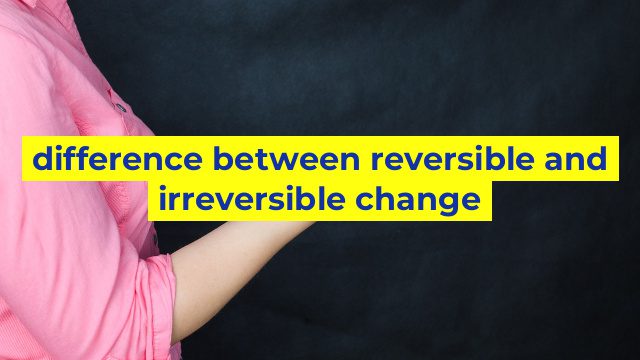Difference between reversible and irreversible changes
Introduction
In the world of science, changes are classified into two categories: reversible and irreversible changes. These changes are studied in physics, chemistry, and biology to understand their effects on various systems. In this article, we will discuss the difference between reversible and irreversible changes.
Reversible changes
Reversible changes are those changes that can be reversed by taking certain actions. These actions can be physical or chemical. For example, when we freeze water, it becomes ice, and this is a reversible change. As we increase the temperature, ice will melt, and it will become water again. Another example of a reversible change is the process of melting and solidifying of wax.
Irreversible changes
Irreversible changes are those changes that cannot be reversed by any means. Once these changes occur, the system cannot be brought back to its original state. For example, when we burn a piece of paper, we cannot bring it back to its initial form. The ash that is left behind after burning cannot be converted back to paper. Similarly, when a plant dies, it cannot be brought back to life.
Differences between reversible and irreversible changes
The main differences between reversible and irreversible changes are:
1. Reversible changes can be reversed by taking certain actions, but irreversible changes cannot be reversed.
2. Reversible changes occur due to changes in conditions such as temperature, pressure, or concentration, but irreversible changes occur due to a chemical reaction or a physical process that changes the structure of the system.
3. Reversible changes do not produce new substances, but irreversible changes produce new substances.
Conclusion
Reversible and irreversible changes are two important concepts in science. It is important to understand the differences between these changes to understand their effects on various systems. Reversible changes are temporary and can be reversed by taking certain actions, whereas irreversible changes are permanent, and the system cannot be brought back to its original state.
Table difference between reversible and irreversible change
Difference Between Reversible and Irreversible Change
| Property | Reversible Change | Irreversible Change |
|---|---|---|
| Definition | A change that can be undone or reversed. | A change that cannot be undone or reversed. |
| Energy transfer | Energy can be transferred back to the system, restoring its initial state. | Energy cannot be transferred back to the system, preventing the restoration of its initial state. |
| Equilibrium | Reversible changes reach equilibrium, where the forward and reverse processes occur at equal rates. | Irreversible changes do not reach equilibrium, and proceed in one direction only. |
| Time | Reversible changes occur over a long period of time. | Irreversible changes occur over a short period of time. |
| Example | Ice melting into water, which can be frozen back into ice. | Cake baking, where the ingredients cannot be separated back into their original form. |
